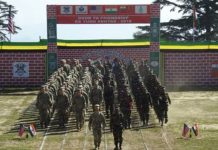 Almost contemporaneously when the ancient Egyptians were constructing their first great pyramids and Mesopotamians were building monumental temples and ziggurats, the Harappans of South Asia were erecting massive baked brick housing complexes and cutting elaborate canal systems. Along with ancient Egypt and Mesopotamia, it was among the world’s first large-scale urban agricultural societies, boasting somewhere between 1 million and 5 million inhabitants across five central cities. This civilization’s abrupt decline, albeit ostensibly, remained one of the great mysteries of the then world.
Almost contemporaneously when the ancient Egyptians were constructing their first great pyramids and Mesopotamians were building monumental temples and ziggurats, the Harappans of South Asia were erecting massive baked brick housing complexes and cutting elaborate canal systems. Along with ancient Egypt and Mesopotamia, it was among the world’s first large-scale urban agricultural societies, boasting somewhere between 1 million and 5 million inhabitants across five central cities. This civilization’s abrupt decline, albeit ostensibly, remained one of the great mysteries of the then world.
Except for physical excavations, which brought out exquisite and obscure artifacts unearthed to date had been the small, square steatite (soapstone) seals engraved with human or animal motifs besides a large number of seals which bore pictographic inscriptions generally thought to be a form of writing or script. Clay and stone tablets unearthed at Harappa, which were carbon dated 3300–3200 BC., contained trident-shaped and plant-like markings. It was highly speculated if a true writing had been found, or that symbols found had any similarities to what became the Indus script. Nevertheless these excavations only established the knowledge and life style in general of the then inhabitants of Indus Valley, nothing authentic material was available about the identity of the inhabitants, who they were, from where they originated etc.
The poor early excavation techniques at Harappa and Mohenjo-daro and the 19th century destruction of much of Harappa had left many pertinent questions unanswered. This woeful dearth of scientific proofs came as a handy tool in the hands of the Left and Evangelical historians to float their empirical theory that ancient Indians (Aryans) came from the West of Harappa, resulting in creation of a totally misleading narrative. Keeping in tune with the left oriented arm chair theorist-historians, few Dravidian theorists operating in several southern states were furthered this theory to de-link the culture, traditions and language of ancient Bharat from the states. They propagated the myth that the ‘Aryans’ invaded the Dravidians who were the ‘original’ inhabitants of the area around Harappa and drove them further south. Since no archaeological or genetic data corroborated this claim, therefore, they empirically proposed the migration myth as per which the ancient Iranians from the West migrated to the Harappan region.
Initially the archaeological excavations revealed the mature Harappan phase represented by planned township having mud-brick as well as burnt-brick houses with a proper drainage system.
A cylindrical seal with 5 Harappan characters on one side and a symbol of an alligator on the other is an important find from this site. The ceramic industry represented by red ware, which included dish-on-stand, vase, perforated jar among others. Other Antiquities, include, blades; terracotta and shell bangles, beads of semi precious stones, and copper objects; animal figurines, toy cart frame and wheel of terracotta; bone points; inscribed steatite seals and sealings. Animal sacrificial pit lined with mud-brick and triangular and circular fire altars on the mud floor have also been excavated that signifies the ritual system of Harappans.
The excavations have yielded a few extended burials, which certainly belong to a very late stage, maybe the medieval times.
With a view to unveil the truth behind the previous archaeological findings emanating from primitive excavation techniques and more so when much more sophisticated techniques and appropriate gadgets are available, the Government of India’s expert archaeologists identified four sites in Hastinapur (Uttar Pradesh), Shivsagar (Assam), Dholavira (Gujarat) and Adichanallur (in Tamil Nadu) for developing them as iconic sites with onsite museums. All this was a sequel to the startling finds in Rakhigarhi (in Hissar District of Haryana), which has now been acclaimed as the largest Harappan site in the Indian subcontinent. Other large sites of Harappan civilization on Indian sub-continent are Harappa, Mohenjodaro and Ganveriwala in Pakistan and Dholavira (Gujarat) in India.
At Rakhigarhi, the excavations are being done to trace its beginnings and to study its gradual evolution from 6000 BCE (Pre-Harappan phase) to 2500 BCE. The site was excavated by one Mr. Amarendra Nath of ASI jointly with Deccan College and the Department of Archaeology and Museums, Government of Haryana. Professor Vasant Shinde from the Post-Graduate and Research Institute of Deccan College led the team of excavators. Dr. Niraj Rai, then from the Centre for Cellular and Molecular Biology (CCMB) Hyderabad and Prof. David Reich from Harvard School of Medicine, Boston, USA led the taeam of Genetic scientists for ancient DNA studies.
The excavations provided an important new insights into the Indus Civilization, which revealed that the Harappan was a dynamic and complicated socio-cultural phenomenon though regionally differentiated, yet sharing some common material cultural attributes. Sustained research at Indus cities has provided the scientists with a greater understanding of their growth, their economies and the societies they developed. Focussed research on aspects of Harappan technology, revealed tremendous sophistication of Harappan craftsmanship, one notable example being of stoneware bangles at Mohenjo-daro.
Although hundreds of skeletons from the Indus Valley have been uncovered, the region’s hot climate rapidly destroys the genetic material that has been instrumental in tracing the history of other early civilizations. From recent knowledge the scientists, which included geneticist David Reich at Harvard University and archaeologist Vasant Shinde at Deccan College in Pune, India, decided to try the promising technique to analyse the human remains found during excavations. They found that the petrous bone of the inner ear contained an unusually high quantity of DNA, allowing them to locate usable genetic material even in otherwise degraded skeletons. Thus they sampled more than 60 skeletal pieces, including numerous petrous bones, before they were able to extract ancient DNA from one. Then they had to sequence the sample more than 100 times to piece together a relatively complete genome.
Rakhigarhi research project finds that a genome from the Indus Valley Civilization is from a population that is the largest source for South Asians. The research authors also show that the population has no detectable ancestry from Steppe pastoralists or from Anatolian and Iranian farmers, suggesting that farming in South Asia arose from local foragers rather than from large-scale migration from the West. Recent findings of DNA from skeletal remains excavated from the Harappan cemetery at Rakhigarhi found that the people in the Harappan Civilization had an independent origin. This study thus negates the empirical propounded by left-oriented vested historians’ theory that the Harappans were having Steppe pastoral or ancient Iranian farmer ancestry. After these authentic findings they all have to shut their shop. The best outcome of the ongoing research is that it establishes beyond doubt that the basic DNA of all inhabitants of this great country, irrespective of their religious affiliation, caste, colour or place of residence whether in east, west, north or south, is the same. Thus it is the imperative need of the hour to try and to unite people of all regions to unite and stand together in the development of this nation and vehemently negate the false propaganda of vested interests based on their negative agenda based theories.
(Next issue-Same Gotra marriage-Is it scientific or an idiosyncrasy?)











